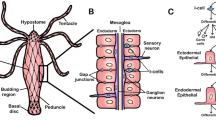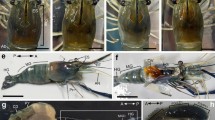Abstract
We review recent experiments showing that the cerebral neuroendocrine Light Green Cells (LGCs) of the freshwater snail,Lymnaea stagnalis, express a family of distinct though related molluscan insulin-related peptide (MIP) genes. The LGCs are involved in the regulation of a wide range of interrelated life processes associated with growth, (energy) metabolism and reproduction. We consider the mechanism of generation of diversity among MIPs, and present evidence that conditions with distinct effects on growth, metabolism and reproduction also can induce distinct patterns of expression of the MIP and schistosomin genes. The stimulus-dependent expression of multiple neuropeptide genes enormously increases the adaptive potential of a peptidergic neuron. We suggest that this contributes significantly to the information-handling capacity of the brain.
Similar content being viewed by others
References
Alpert, S., Hanahan, D., and Tertelman, G., Hybrid insulin genes reveal a developmental lineage for pancreatic endocrine cells and imply a relationship with neurons. Cell53 (1988) 295–308.
Benjamin, P. R. Swindale, N. V., and Slade, C. T., Electrophysiology of identified neurosecretory neurons in pond snailLymnaea stagnalis (L.), in: Neurobiology of Invertebrates. Gastropoda Brain, pp. 85–100. Ed J. Salanki. Akademiai Kiado, Budapest 1976.
Blundell, T. L., and Wood, S. P., Is the evolution of insulin Darwinian or due to selectively neutral mutation? Nature257 (1975) 197–203.
Blundell, T. L., and Humbelm, R. E., Hormone families: pancreatic hormones and homologous growth factors. Nature287 (1980) 781–787.
Daughaday, W. H., and Rotwein, P., Insulin-like growth factors I and II. Peptide, messenger ribonucleic acid and gene structures, serum, and tissue concentrations. Endocr. Rev.10 (1989) 68–91.
Froesch, E. R., Schmidt, C., Schwander, J., and Zapf, J. A., Actions of insulin-like growth factors. Ann. Rev. Physiol.47 (1985) 443–467.
Geraerts, W. P. M., Control of growth by the neurosecretory hormone of the light green cells in the freshwater snailLymnaea stagnalis. Gen. comp. Endocr.29 (1976) 61–67.
Geraerts, W. P. M., The role of the lateral lobes in the control of growth and reproduction in the hermaphrodite freshwater snailLymnaea stagnalis. Gen. comp. Endocr.29 (1976) 97–108.
Geraerts, W. P. M., Neurohormonal control of growth and carbohydrate metabolism by the light green cells inLymnaea stagnalis. Gen. comp. Endocr., in press.
Geraerts, W. P. M., and Joosse, J., The control of vitellogenesis and of growth of female accessory sex organs by the dorsal body hormone (DBH) in the hermaphrodite freshwater snailLymnaea stagnalis. Gen. comp. Endocr.27 (1975) 450–467.
Geraerts, W. P. M., ter Maat, A., and Vreugdenhil, E., The peptidergic neuroendocrine control of egg-laying behavior inAplysia andLymnaea, in: Endocrinology of Selected Invertebrate Types, pp. 141–231. Eds H. Laufer and G. H. Downer. Alan R Liss, New York 1988.
Geraerts, W. P. M., and Smit, A. B., The role of peptide diversity in the molluscan CNS, in: Molluscan Neurobiology, pp. 300–308. Eds K. S. Kits, H. H. Boer and J. Joosse. North Holland Publishing Comp. Amsterdam 1991.
Geraerts, W. P. M., Vreugdenhil, E., and Ebberink, R. H. M., Bioactive peptides in molluscs, in: Invertebrate Peptide Hormones, pp. 377–468. Eds M. C. Thorndyke and G. Goldsworthy. Cambridge University Press, Cambridge 1988.
Geraerts, W. P. M., Smit, A. B., Li, K. W., Vreugdenhil, E., and van Heerikhuizen, H., Neuropeptide gene families that control reproductive behaviour and growth in molluscs, in: Current Aspects of the Neurosciences, pp. 256–305. Ed. N. N. Osborne. The Macmillan Press Ltd, London 1991.
Girbau, M., Gomez, J. A., Lesniak, M. A., and Pablo, F. de, Insulin and insulin-like growth factor I both stimulate metabolism, growth and differentiation in the postneurula chick embryo. Endocrinology121 (1987) 1477–1482.
Hordijk, P. L., Schallig, H. D. F. H., Ebberink, R. H. M., de Jong-Brink, M., and Joosse, J., Primary structure and origin of schistosomin, an anti-gonadotropic neuropeptide of the pond snail,Lymnaea stagnalis. Biochem. J., submitted.
Joosse, J., Dorsal bodies and dorsal neurosecretory cells of the cerebral ganglia ofLymnaea stagnalis. L. Arch. neerl. Zool.15 (1964) 1–103.
Kawakami, A., Iwami, M., Nagasawa, H., Suzuki, A., and Ishizaki, H., Structure and organization of four clustered genes that encode bombyxin, an insulin-related brain secretory peptide of the silkmothBombyx mori. Proc. natl Acad. Sci. USA84 (1989) 6843–6847.
van Kesteren, R. E., Smit, A. B, Dirks, R. W., De With, N. D., Geraerts, W. P. M., and Joosse, J., Evolution of the vasopressin/oxytocin superfamily: Characterization of a vasopressin-related precursor, preproconopressing from the mollusc,Lymnaea stagnalis. Proc. natl. Acad. Sci. USA, in press.
Kits, K. S., Bobeldijk, R. C., Crest, M., and Lodder, J. C., Glucose-induced excitation in molluscan neurons producing insulin-related peptides. Pflügers Arch.417 (1991) 597–604.
Kits, K. S., and Lodder, J. C., cAMP increases excitability in growth hormone producing neurones by enhancement of Ca-current, in: Neurobiology of Invertebrates; Transmitters, Modulators and Receptors. Symp. biol. hung.36 (1988) 655–667.
Linacre, A., Kellet, E., Saunders, S., Bright, K., Benjamin, P. R., and Bruke, J. F., Cardioactive neuropeptide Phe-Met-Arg-Phe-NH2 (FM-RFamide) and novel related peptides are encoded in multiple copies by a single gene in the snailLymnaea stagnalis. J. Neurosci.10 (1990) 412–419.
van Minnen, J., Reichelt, D., and Lodder, J. C., An ultrastructural study of the neurosecretory Canopy Cell of the pond snailLymnaea stagnalis (L.), with the use of the horseradish peroxidase tracer technique. Cell Tiss. Res.214 (1980) 453–462.
Petersen, O. H., Findlay, I., Suzuki, K., and Dunne, M. J., Messengermediated control of potassium channels in secretory cells. J. exp. Biol.124 (1986) 33–52.
Robitzki, A., Schroder, H. C., Ugarkovic, D., Pfeifer, K., Uhlenbruck, G., and Muller, W. E. G., Demonstration of an endocrine circuit for insulin in the sponge,Geodia cydonium. EMBO J.8 (1989) 2905–2909.
Smit, A. B., Vreugdenhil, E., Ebberink, R. H. M., Geraerts, W. P. M., Klootwijk, J., and Joosse, J., Growth-controlling molluscan neurons produce the precursor of an insulin-related peptide. Nature331 (1988) 535–538.
Steiner, D. F., and Chan, S. J., Perspective: An overview of insulin evolution. Horm. Metabol. Res.20 (1988) 443–444.
Steiner, D. F., Chan, S. J., Welsh, J. M., and Kwok, S. C. M., Structure and evolution of the insulin gene. A. Rev. Genet.19 (1985) 463–468.
de Vlieger, T. A., Lodder, J. C., Werkman, T. R., and Stoof, J. C., Change in excitability in growth hormone producing cells ofLymnaea stagnalis induced by dopamine receptor stimulation, in: Neurobiology: Molluscan Models, pp. 172–178. Eds H. H. Boer, W. P. M. Geraerts and J. Joosse. North-Holland Publ. Comp., Amsterdam 1987.
Vreugdenhil, E., Jackson, J. F., Bouwmeester, T., Smit, A. B., van Minnen, J., van Heerikhuizen, H., Klootwijk, J., and Joosse, J., Isolation, characterization, and evolutionary aspects of a cDNA clone encoding multiple neuropeptides involved in the stereotyped egg-laying behavior of the freshwater snailLymnaea stagnalis. J. Neurosci.8 (1988) 4184–4191.
Wendelaar Bonga, S. E., Ultrastructure and histochemistry of neurosecretory cells and neurohaemal areas in the pond snailLymnaea stagnalis (L.). Z. Zellforsch.108 (1970) 190–224.
Author information
Authors and Affiliations
Rights and permissions
About this article
Cite this article
Geraerts, W.P.M., Smit, A.B., Li, K.W. et al. The Light Green Cells ofLymnaea: A neuroendocrine model system for stimulus-induced expression of multiple peptide genes in a single cell type. Experientia 48, 464–473 (1992). https://doi.org/10.1007/BF01928165
Published:
Issue Date:
DOI: https://doi.org/10.1007/BF01928165




